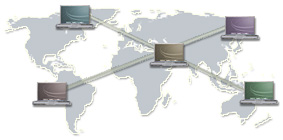Network formation and social capital can happen both in place and space, that is, geographical places such as neighbourhoods and communities, and virtually on-line, in chat rooms and the more recent BLOG formations. Led by principal investigator Ann Dale, and Gillian Kerr, this case study is looking at the network formation underlying the anti-Iraqi war BLOG formation.
Particular questions of interest are:
- Are BLOGS independent of place or is there any particular geographic clustering?
- Do BLOGS facilitate a 'voice' and diversity of opinion that would not necessarily be heard anywhere else?
- Are there specific demographics associated with BLOGS?
- Do they exhibit different patterns of network formation than place-based networks?
The Internet and the Iraq War II
During the war in Iraq the Internet was used substantially as a means of exchanging information, organizing events and motivating groups/ individuals to act; supporters of the war also used it, to a less strategic extent. A particular phenomenon of the Internet that has become widely popular in the past year is the web log. Used in common Internet language ‘web logging’ has come to be known as ‘blogging’. The history of this new tool was timely in respect to this war.
The issue of the Internet’s influence on the war in Iraq is not new. A pilot study conducted by the Centre for Public Communication Research in Dorset, UK, monitored the influence of the Internet in the ‘run-up to the 2nd Gulf War’. The results of this study indicated that not only was the influence mild and secondary, but that there was a distinction of age; younger people were more apt to get information from the ‘net’ and the older members of the study did not trust the internet for information exchange and recruitment. The study noted that the main obstacle to the greater use of the Internet by local activists was "access". Communicators did not consider email as a resource capable of reaching lay citizens in small or isolated communities and, therefore, used it as a "reminder" where available (Gerodimes, 2003).
Blogs and Global Mobilisation
Where did blogging come from and how has it come to be such a common tool.
A weblog, or simply blog, is a website which contains periodic, reverse chronologically ordered posts on a common webpage. The idea of web logging has been around for years, say IT experts at Wired, but it was when Google bought the company Blogger, that this once obscure method of exchange became ‘hip’ and popular.
Blogs are free to set up in most cases and provide instant access to the global internet base. However, just as important as the instantaneous access is the anonymity that blogs can provide. A safe method of providing information without the fear of persecution, a factor that has become absolutely important to those people in regions that have clamped down violently against such admission of situations.
The Blog Phenomena and the Iraq War
The oft claimed ‘most famous’ Iraq war blog was that of Salam Pax’s, ‘Dear Raed’. In the run-up to the war, Pax wrote a compelling journal of daily life in the Iraqi capital, posted regularly on his weblog. For many the access to his insider's view of the impending war was a brillant awakening of understanding. Blogs spun off of Salam’s ‘Dear Raed’ click for blog siteand the global Internet community explored the power of the free exchange of this information.
Critics of this new mode of information exchange questioned the underpinnings of the blog for communication and advocacy, especially the question of authenticity. Who is writing blogs? With no geographic locators, the idea that anyone could be Salam persisted. Regardless of this doubt, after the war broke out, Pax's site was featured in hundreds of news stories, including pieces by MSNBC, the BBC, The New York Times and The Washington Post (Kahney, 2003). The significance of the blog was evident, but how does this link to the formation of community? To the building of social capital?
The Development of a Case Study Model
The authors of this case study were inspired and enlightened by the artistic impressions of corruption and power in the current age, as created by the late Mark Lombardi. Lombardi was an artist that was deeply moved by the corruption he was observing in his home country. From his studio in New York City, click for Lombardi articleLombardi detailed diagrammatic drawings of high-profile financial and political scandals involving government and corporate personnel from all over the world.
What Lombardi’s web provided was a tangible, tactile mechanism to plot or log the observed relationship between blogs and the global antiwar movement? A key issue at the forefront of this plotting was in what the links would or could represent, (i.e. geography, time, interests, events, people, blogs sites). While the mapping is in progress it has been observed that several layers representing different linkages is possible. The results of these maps and the research to date will be presented in 2005 with the results of the case study.